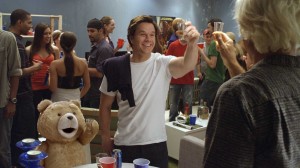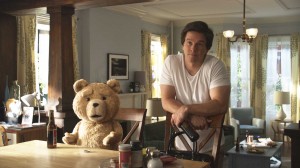
“You get involved in every single show,” Clark reflects. And since those “shows” have included films like Beverly Hills Chihuaha, Cats and Dogs, the sequel, Kitty Galore, Smurfs and The Spiderwick Chronicles, he knows what he is talking about when discussing his latest work on Seth MacFarlane’s raunchy comedy, Ted. “If you have to work on a talking animal,” Clark says of the titular stuffed bear, “Ted is at the top of the heap.”
VFX producer Jenny Fulle, of L.A.-based The Creative Cartel, had spent two years on Ted when she was interviewed.
Those years meant a different working methodology for both Fulle – who was used to more traditional FX, as in Ghost Rider: Spirit of Vengeance and Priest – and Clark, from his own perch at Berkeley’s Tippett Studio. For one thing, Ted is an R-rated comedy, a la The Hangover, not a PG-13 family-friendly tentpole. And it was budgeted accordingly. But there would still be digits – critically so, since the title character was comprised of them. “Everyone was unwilling to compromise on the quality,” Fulle said.

Fulle recalls MacFarlane announcing, “This is my bear,” after looking at the previs. “Iloura knocked the test out of the ballpark,” Fulle said, and the studio evidently agreed.
This worked well for Clark. When Tippett came on shortly after, there was a “pre-approved look and character” to the film’s fuzzy lead character; which already had MacFarlane’s voice. “Usually, they’re sweating bullets,” Clark said, referring to the wait for studio approvals, but for this project, approvals had been given at the outset.
One of the next steps was to assign sequences between Iloura and Tippett, so that Iloura’s bear would never have to be directly cut with Tippetts’ in the same scene. Fulle recounts that a key decision was to agree that action would to be handled at one house, and talking would be this handled at the other house.
And while the voicing and talking comes naturally to MacFarlane – who seems to be overseeing, and voice acting in innumerable animated series these days – the action of the brought-to-life bear brings us back to Serkis territory.
MacFarlane didn’t have time to pull a Serkis act, since he was also directing/writing/producing Ted. Additionally, Ted’s limbs were too stubby, and Macfarlane’s arms and legs would have be redone and re-blocked anyway. But some of his body movements and head turns were used, along with lots of hi-def footage of his face, which was later used for reference in subtle expressions such as eye-widening movements, curled lips, etc.

“Seth didn’t have to walk around in a Lycra unitard,” Fulle said, “We didn’t have the luxury to do that, on many levels.”
Another traditional way of working that was put aside in favor of a twist, was the process of first rendering, then sculpting an animated character and trying to match the two versions.
Instead, digital files were sent to Mark Rappaport’s Creature Effects, where he came up with the “real” plush version of Ted. Not only did this serve as the initial prop bear, but this allowed Clark to do crude puppeteering and to see how lighting would fall on what became known as the “stuffy.” This information was then used to render the talking, booze-swilling Ted later on.
The stuffed bear also gave star Mark Wahlberg something to interact with, Clark noted, though there was a lot of other interaction in principal photography, before the rendering in post got fully underway.
One climactic interaction was a fight between Wahlberg and the bear. Stunt coordinator Kyle Woods went in and built the set, replicating the room where Wahlberg’s half of the scene was filmed. “I choreographed the fight, which became the blueprint of the sequence in principal photography,” Woods said. This allowed them to finish the sequence in two days.
Fulle observes that MacFarlane is a great multi-tasker, and his days are always full, fight sequences or no. To help him keep up with dailies and sequences for Ted, they used a combination of cineSync and Skype, which is relatively standard in the world of postproduction effects work. But this was unusual for MacFarlane at first, Fulle said.
They fixed him with up with a Cintiq tablet, allowing him to draw directly on the frames as he saw them. The animator in him had been unleashed, which helped to nail down the last bit of Ted’s performance.
“It was one big happy family,” Fulle said. “An amazing project. We got to be like 13 year-old adolescents.”
Were that the case, this “family” of filmmakers would not be allowed into the R-rated film without adult supervision. On the other hand, Ted the bear – drink in hand – would heartily approve if they did it anyway.





